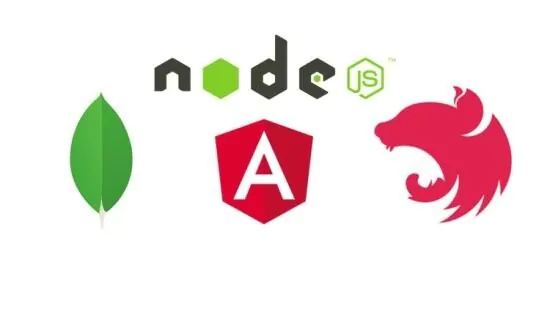
术语MEAN栈是指用于开发Web应用程序的基于JavaScript的技术的集合。MEAN是MongoDB,ExpressJS,Angular和NodeJS的首字母缩写。从客户端到服务器再到数据库,MEAN是全栈JavaScript。
选择MEAN栈而不是其他栈的主要原因是因为客户端和服务器端都使用了通用语言。由于所有这些技术都是用JavaScript编写的,因此您的Web开发过程变得整洁。Node.js是一个在服务器端实现JavaScript实现的平台。通过在前端使用JavaScript的Angular,可以更轻松地从后端到前端重用代码。
MEAN堆栈为Web开发提供了一种现代方法。它还利用了现代SPA(单页应用程序)的功能,就像大多数传统的Web应用程序一样,它不需要为每个服务器请求完全刷新网页。如今,有一种趋势是开发对应于一种编程语言并形成全栈解决方案的多个框架。但是,到目前为止,使用MEAN堆栈是一种非常有效的Web开发方法。
在本课程中,我们将构建后端应用程序Nest.js。Nest.js是一个Node.js框架。它建立在Express和Typescript的顶部。
Nest.js是一个渐进式Node.js框架,用于构建高效,可靠和可扩展的服务器端应用程序。NestJS是一个服务器端(后端)应用程序框架,其设计精巧,可支持开发人员提高工作效率并使他们的生活更快乐。嗯,这不仅是一个框架,而且是进入高级工程概念世界的推动力,例如域驱动设计,事件源,微服务体系结构。
SVIP免费当前隐藏内容需要支付49元
已有0人支付
MP4 | Video: h264, 1280×720 | Audio: AAC, 44.1 KHz, 2 Ch
Genre: eLearning | Language: English + .srt | Duration: 94 lectures (11h 23m) | Size: 5.36 GB
Modern MEAN Stack web Application development with Node.js, Angular, Nestjs, MongoDB
What you’ll learn:
NestJs Fundamentals
Typescript Fundamentals
Angular Fundamentals
Build RESTFUL APIs with NestJs and MongoDB
Build RestFUL APIs with NestJs and Mysql
Authentication and Authorization using PassportJs
Add Documentation for your APIS
Build Single Page frontend app with Angular
CRUD Application with Angular
Authentication in Angular Application
Requirements
Having a basic understanding of JavaScript and/or NodeJS
Having basic knowledge of TypeScript is recommended, but not required
Description
The term MEAN stack refers to a collection of JavaScript based technologies used to develop web applications. MEAN is an acronym for MongoDB, ExpressJS, Angular and Node.js. From client to server to database, MEAN is full stack JavaScript.
The main reason for choosing the MEAN stack over others is because of the use of a common language for both client-side and server-side. Since, all these technologies are written in JavaScript, your web development process becomes neat. Node.js is a platform that brought JavaScript implementation on the server-side. With Angular using JavaScript on the front-end, it becomes easier to reuse code from back-end to front-end.
MEAN stack offers a modern approach to web development. It also makes use of the power of modern SPAs (single-page applications), which does not require entirely refreshing a web page for every server request like most traditional web applications do. Today there is a trend to develop multiple frameworks that correspond to a single programming language and form a full-stack solution. But, as of now, using MEAN stack is a very effective approach to web development.
In this course, we are going to build our backend application Nest.js. Nest.js is a Node.js framework. It is built on the top of Express and Typescript.
Nest.js is a progressive Node.js framework for building efficient, reliable and scalable server-side applications. NestJS is a server-side (backend) application framework beautifully crafted to support developers productivity and make their lives happier. Well, it’s not only a framework, it’s an enabler of entering the world of advanced engineering concepts such as Domain Driven Design, Event Sourcing, Microservices architecture.
I spent a good few years in my career developing large scale apps and it didn’t let me down any single time. It’s well written, having quality as an objective, modular web framework with a good documentation, delivering nice developer experience. Exactly the same way I’d describe Nest.
NestJs is built on the top of Typescript and Express.js. It also combines some elements of Object Oriented Programming and functional programming.
Here comes NestJS, a framework which is fully written in TypeScript (it supports JS too, but types are good), it’s easily testable and brings in all the necessary stuff you always think about but you don’t know what to choose.
Why NestJs?
NestJS doesn’t try to limit you to a particular way of doing things, it just provides the tooling you need. It doesn’t try to reinvent the wheel, it utilize existing tools you already know. For example, it uses express behind the scenes which makes your app compatible with the majority of express middlewares.
Here are some good reasons why NestJS shines:
Dependency Injection — NestJS provides DI straight out of the box, increasing efficiency, modularity and testability of applications.
Modularisation — NestJS provides a modular structure for organizing code within the same domain boundary into separate modules.
Flexibility — NestJS provides structure, which helps large teams build complex applications and yet comes in as lightweight as possible, so how you want to build is your choice.
Familiar APIs you already know — NestJS is heavily inspired by Angular, it is also quite similar to much established frameworks like Spring and .NET. This provides a shorter learning curve and lower entry threshold for developers.
Community — NestJS is the fastest rising framework, already with 14K stars surpassing HapiJS. Also, with NestJS leveraging on the Angular way of doing things, things can only get better for the community.
In this course, I will teach you the foundations/fundamentals of NestJs. I will teach you how to build RESTFUL APIs step by step. You will also learn how to plan, design and deploy APIs. I have also another separate section of GraphQL.
What you are going to learn in this course?
Typescript Fundamentals
NestJs Fundamentals
Angular Fundamentals
Build RESTFUL APIs with NestJs
Connect REST APIs with Angular
Build Frontend with Angular
Authentication on Angular
Authentication on Backend Application
Who this course is for
Intermediate JavaScript developers who want to dive into back-end development
Any developer wants to learn how to build backend server side applications with Typescript
Developers who want to learn how build Restful apis with NestJs, MongoDB and MySQL
Developers who want to learn how to secure your APIs using JWT
Developers who want to learn how to deploy NestJs application
Developers who want to learn how to learn how to build MEAN Stack App with Nestjs and Angular
Developers who want to learn how to consume RESTFUL APIs with Angular
